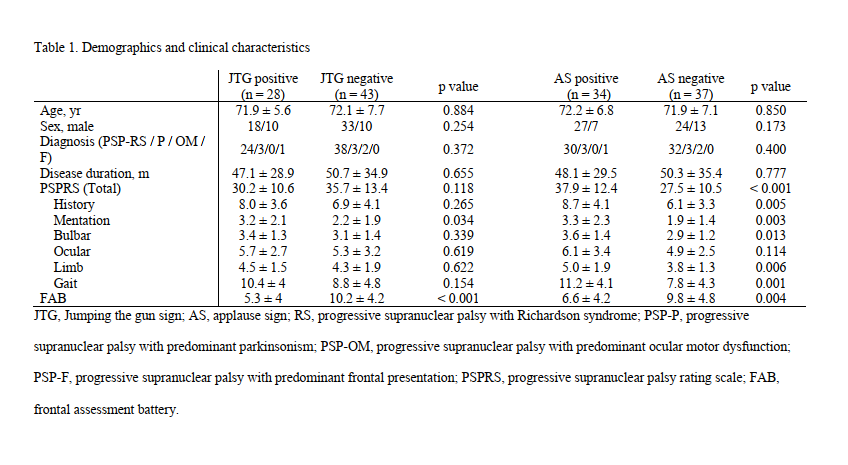Category: Parkinsonism, Atypical: PSP, CBD
Objective: We presumed that the “jumping the gun sign (JGS)” is caused by an impairment of “waiting impulsivity” rather than “stopping impulsivity”, as seen on the applause sign (AS). We investigated clinical feature of the progressive supra nuclear palsy (PSP) patients with JGS and the patients without JGS.
Background: The impulsivity and inhibitory deficits of PSP patients has been reported and it can be presented as “applause sign (AS)”, which is defined as performing more than three claps in three-clap test (TCT). The AS is cause by the patients couldn’t “stopping” their behavior. Some patients with PSP showed beginning of clapping prior to the “start” signal while TCT, we coin it as “Jumping the Gun Sign”. The JGS might be induced by different mechanism from AS.
Method: The three-clap test was applied to detect the presence of the JTG sign and AS. Examiners demonstrated the TCT then the patients asked to clap three times as quickly as possible, when the physician say “start”. Normal (negative) JGS was defined as clapping three times after start signal and abnormal (positive) JGS was defined as participant start to clap before the start signal. AS is considered as normal when he or she claps only three times and abnormal AS is defined as when he or she claps more than four times. We investigated age, sex, disease duration, subtype of PSP, PSP-rating scale (PSPRS), frontal assessment battery (FAB), as well.
Results: A total of 71 probable PSP patients were included. Twenty-eight patients with PSP had positive JGS (39.4%) and 43 were negative in JGS (60.6%). There were no differences in mean age, sex, subtypes of PSP, disease duration, and PSP rating scale. Positive JGS group had the higher PSPRS mentation and the lower FAB, than negative JGS group. In terms of AS, 34 patients were positive in AS and 37 were negative. Unlikely from JGS, the patients with positive AS had the higher PSPRS total and subscores except ocular, and the lower FAB than the negative AS group.
Conclusion: In this study, we firstly described “The Jumping the Gun Sign” of the patients with PSP and the results suggested that JTG in PSP is associated with the frontal lobe dysfunction than motor function of PSP, unlike AS. The present of JGS might be induced by dysfunction of waiting impulsivity caused by frontal lobe dysfunction.
To cite this abstract in AMA style:
JH. Ahn, J. Youn, YE. Huh, JW. Cho. Jumping the Gun Sign: a sign for “Waiting Impulsivity” of progressive supranuclear palsy [abstract]. Mov Disord. 2022; 37 (suppl 2). https://www.mdsabstracts.org/abstract/jumping-the-gun-sign-a-sign-for-waiting-impulsivity-of-progressive-supranuclear-palsy/. Accessed December 18, 2025.« Back to 2022 International Congress
MDS Abstracts - https://www.mdsabstracts.org/abstract/jumping-the-gun-sign-a-sign-for-waiting-impulsivity-of-progressive-supranuclear-palsy/

